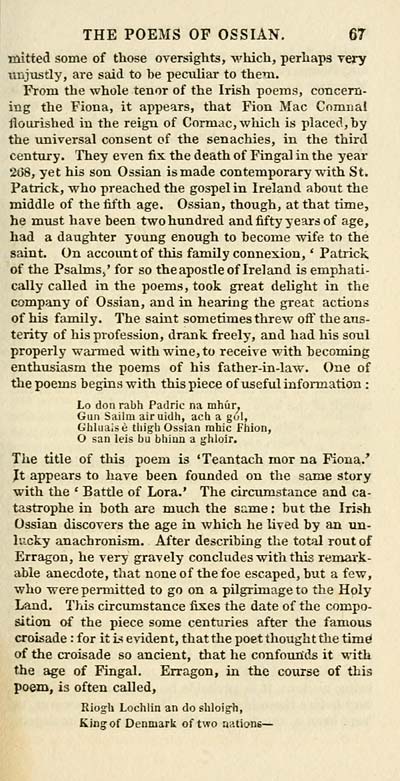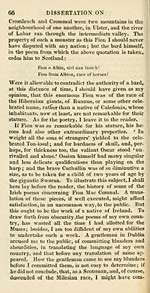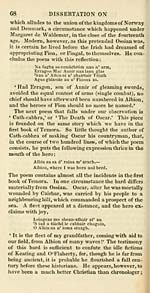Ossian Collection > Poems of Ossian
(75)
Download files
Complete book:
Individual page:
Thumbnail gallery: Grid view | List view

THE POEMS OF OSSIAN. 67
tnitted some of those oversights, which, perhaps very
unjustly, are said to be peculiar to them.
From the whole tenor of the Irish poems, concern-
ing the Fiona, it appears, that Fion Mac Comnal
flourished in the reign of Cormac, which is placed, by
the universal consent of the senachies, in the third
century. They even fix the death of Fingal in the year
2(58, yet his son Ossian is made contemporary with St.
Patrick, who preached the gospel in Ireland about the
middle of the fifth age. Ossian, though, at that time,
he must have been two hundred and fifty years of age,
had a daughter young enough to become wife to the
saint. On account of this family connexion, * Patrick,
of the Psalms,' for so theapostle of Ireland is emphati-
cally called in the poems, took great delight in the
company of Ossian, and in hearing the great actions
of his family. The saint sometimes threw off the aus-
terity of his profession, drank freely, and had his soul
properly warmed with wine, to receive with becoming
enthusiasm the poems of his father-in-law. One of
the poems begins with this piece of useful information :
Lo don rabh Padric na mhur^
Gun Sailm airuidh, ach a gol,
Ghliiaise tliigli Ossian mhic Fhion,
O san leis bu bhinn a ghloir.
The title of this poem is 'Teantach mor na Fiona.'
Jt appears to have been founded on the same story
with the • Battle of Lor a.' The circumstance and ca-
tastrophe in both are much the st:me : but the Irish
Ossian discovers the age in which he lived by an un-
lucky anachronism. After describing tlie total rout of
Erragon, he very gravely concludes with this remark-
able anecdote, that none of the foe escaped, but a few,
who were pennitted to go on a pilgrimage to the Holy
Land. Tliis circumstance fixes the date of the compo-
sition of the piece some centuries after the famous
croisade : for it Ls e\'ident, that the poet thought the time!
of the croisade so ancient, that he confounds it with
the age of Fingal. Erragon, in the course of this
poem, is often called,
Riogh Lochlin an do shloi^h,
King of Denmark of two riations—
tnitted some of those oversights, which, perhaps very
unjustly, are said to be peculiar to them.
From the whole tenor of the Irish poems, concern-
ing the Fiona, it appears, that Fion Mac Comnal
flourished in the reign of Cormac, which is placed, by
the universal consent of the senachies, in the third
century. They even fix the death of Fingal in the year
2(58, yet his son Ossian is made contemporary with St.
Patrick, who preached the gospel in Ireland about the
middle of the fifth age. Ossian, though, at that time,
he must have been two hundred and fifty years of age,
had a daughter young enough to become wife to the
saint. On account of this family connexion, * Patrick,
of the Psalms,' for so theapostle of Ireland is emphati-
cally called in the poems, took great delight in the
company of Ossian, and in hearing the great actions
of his family. The saint sometimes threw off the aus-
terity of his profession, drank freely, and had his soul
properly warmed with wine, to receive with becoming
enthusiasm the poems of his father-in-law. One of
the poems begins with this piece of useful information :
Lo don rabh Padric na mhur^
Gun Sailm airuidh, ach a gol,
Ghliiaise tliigli Ossian mhic Fhion,
O san leis bu bhinn a ghloir.
The title of this poem is 'Teantach mor na Fiona.'
Jt appears to have been founded on the same story
with the • Battle of Lor a.' The circumstance and ca-
tastrophe in both are much the st:me : but the Irish
Ossian discovers the age in which he lived by an un-
lucky anachronism. After describing tlie total rout of
Erragon, he very gravely concludes with this remark-
able anecdote, that none of the foe escaped, but a few,
who were pennitted to go on a pilgrimage to the Holy
Land. Tliis circumstance fixes the date of the compo-
sition of the piece some centuries after the famous
croisade : for it Ls e\'ident, that the poet thought the time!
of the croisade so ancient, that he confounds it with
the age of Fingal. Erragon, in the course of this
poem, is often called,
Riogh Lochlin an do shloi^h,
King of Denmark of two riations—
Set display mode to: Large image | Transcription
Images and transcriptions on this page, including medium image downloads, may be used under the Creative Commons Attribution 4.0 International Licence unless otherwise stated. ![]()
| Early Gaelic Book Collections > Ossian Collection > Poems of Ossian > (75) |
|---|
| Permanent URL | https://digital.nls.uk/81238769 |
|---|
| Description | Selected books from the Ossian Collection of 327 volumes, originally assembled by J. Norman Methven of Perth. Different editions and translations of James MacPherson's epic poem 'Ossian', some with a map of the 'Kingdom of Connor'. Also secondary material relating to Ossianic poetry and the Ossian controversy. |
|---|
| Description | Selected items from five 'Special and Named Printed Collections'. Includes books in Gaelic and other Celtic languages, works about the Gaels, their languages, literature, culture and history. |
|---|

